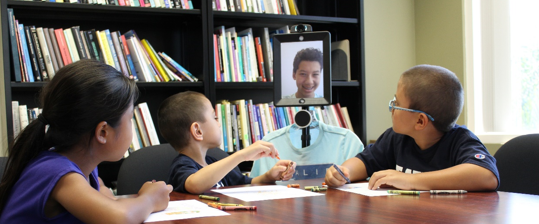By Savannah Gray. Being a student is tough. On top of trying to succeed academically, one has to navigate the social aspect of making friends, interacting with others, and figuring out one’s identity. Now, imagine doing all that while being homebound. UC Irvine Informatics Professor Emeritus Judy Olson and NIH-funded Postdoctoral Fellow Veronica Newhart can help. They use groundbreaking technology – telepresence robots – to help students with chronic illnesses go from homebound to school bound.
What is telepresence learning?
Telepresence robots refer to technologies that allow a user to learn in a space that they do not physically inhabit. In the case of Olson and Newhart, the technology is an advanced robot with an iPad attached that allows the homebound student to see and communicate in-class. The student can move the robot around remotely, interact with other students, and experience an authentic learning environment. A key example of someone who would benefit from telepresence learning is a child needing a heart transplant. This child is still 100% cognitively able to learn but their illness or disability prohibits them from physically attending school.
From telemedicine to education
The telepresence robots were introduced to UC Irvine just last year, but many students are already borrowing the robots through Disability Services. How did the influential and innovative project start? Newhart was exploring the use of telepresence robots by homebound pediatric patients for her dissertation research. Professor Olson had years of experience with telemedicine (technology that allows a doctor to work remotely in his/her interactions with patients), and provided her expertise when Newhart contacted her for mentorship on the project.
Newhart completed her first case study in 2013. In 2014, the project grew by combining Olson’s technological background and Newhart’s public health and sociological background. Once a student begins using the telepresence robot, Newhart regularly visits them and tracks their physical and emotional progress. For many, the results aren’t only increased retention of information but also a noticeable improvement in energy and overall mood.
Newhart has now conducted dozens of case studies involving a wide range of students, and has received her PhD on the topic. Olson is now retired, or as she quipped, on a “self-funded extended sabbatical,” but she still provides support to Newhart and the students. After spending over five years researching telepresence learning, she and Newhart have limitless anecdotes on how homebound students have thrived due to their newfound mobility.
The value of showing up as a robot
The value of telepresence robots can be summed up in a quick anecdote. Newhart mentioned that she always asks the children using the technology, along with their parents, what they like most about the robots. She said one parent told her their son “had been on homebound services for a long time, and when he started using the robot, they walked into the child’s room and heard him laughing. They hadn’t heard him laugh in over a year.”
Newhart added, “There’s this resilience to children and young adults that I think a lot of people underestimate. And many students that I meet when I go out and do the interviews say it’s not easy to show up as a ‘robot,’ even for the adults.” Many adults are afraid to drive the robot for fear of looking awkward, but “the students are not,” Newhart said. “Many excitedly jump right in, especially when they’ve been homebound for a long period of time.”
The future is bright
Although much progress has been made since the pair started their research, both Olson and Newhart agree that much more can be done. Through her postdoctoral work, Newhart plans to continue this research and grow a national database on this practice. Additionally, the only telepresence robots on the market were designed for the corporate and medical spheres and thus can be inaccessible to many because of their price. Therefore, they both want to contribute to the design of robots specifically designed for educational purposes that are affordable.
Olson said, “There are policy implications as well as questions about what school systems have to offer to a student that is homebound. I think there’d be a huge market for these robots, so I think we have a lot to do. It’s very exciting though—we can help these kids, we can help these families.”
 Savannah Gray is a UC Berkeley student intern in IT marketing and communications at the UC Office of the President.
Savannah Gray is a UC Berkeley student intern in IT marketing and communications at the UC Office of the President.

